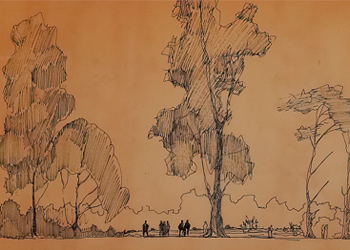A certain idea of garden

The new “digital archive” of the Gulbenkian Garden features a selection of documents detailing the origins and development of the Gulbenkian Garden project.
Know the digital archive
This database incorporates over 600 documents, including technical designs, sketches, minutes of meetings, photographs, notes and jottings. This documentation belongs both to the Calouste Gulbenkian Foundation Art Library and Archive and to the personal legacies of Gonçalo Ribeiro Telles and António Viana Barreto, spanning information on this site reaching from the 17th century through to 2000. In the medium term, there will be the opportunity to consult an English version of the curatorial texts and the search tools as well as further documentation, especially detailing the post-2000 interventions.
At the beginning of the 1960s, the landscape architects Gonçalo Ribeiro Telles and António Viana Barreto began the intense work that led to the design of what would become the Calouste Gulbenkian Park, inaugurated in 1965. Neither of the pair would have imagined the relevance that their work would later come to hold. The new ideas that the modernist movement advocated inspired these architects to adopt a transformative role in the citizen’s quality of life. Furthermore, there was, according to Ribeiro Telles, a great “drama” in Portuguese intellectual life over just what a garden was.
This project turned out to clearly break with the practices of the period. This correspondingly generated a new way of designing the “garden”, based on a subtle geometry, which provided spaces and ambiences rather than axes, and where the geography and vegetation celebrate the Portuguese landscape – out of which stems the true Portuguese Garden. The reproduction of the ecological codes of the Portuguese landscape reflected in the choice, combination and location of the plant species, the dialogue between the thicket and the clearing and the coppice of trees, evoke situations, “micro-landscapes”, which are not only familiar to ourselves, humans, but also the wild fauna attracted here.
This means of working the place based upon landscaping rules constitutes a deep characteristic of the Portuguese school of landscape architecture with its roots in the German school and that reaches the very pinnacle of its expression in this garden.
